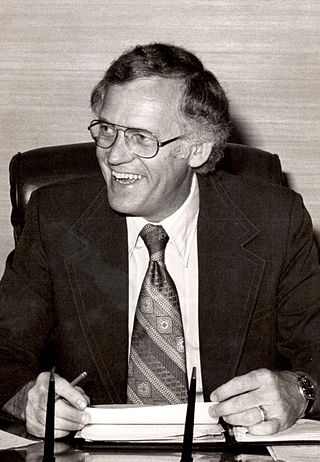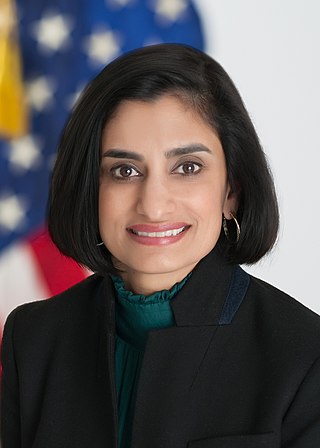
In the United States, Medicaid is a government program that provides health insurance for adults and children with limited income and resources. The program is partially funded and primarily managed by state governments, which also have wide latitude in determining eligibility and benefits, but the federal government sets baseline standards for state Medicaid programs and provides a significant portion of their funding.

The United States Department of Health and Human Services (HHS) is a cabinet-level executive branch department of the U.S. federal government created to protect the health of the U.S. people and providing essential human services. Its motto is "Improving the health, safety, and well-being of America". Before the separate federal Department of Education was created in 1979, it was called the Department of Health, Education, and Welfare (HEW).

Medicare is a federal health insurance program in the United States for people age 65 or older and younger people with disabilities, including those with end stage renal disease and amyotrophic lateral sclerosis. It was begun in 1965 under the Social Security Administration (SSA) and is now administered by the Centers for Medicare and Medicaid Services (CMS).
Diagnosis-related group (DRG) is a system to classify hospital cases into one of originally 467 groups, with the last group being "Ungroupable". This system of classification was developed as a collaborative project by Robert B Fetter, PhD, of the Yale School of Management, and John D. Thompson, MPH, of the Yale School of Public Health. The system is also referred to as "the DRGs", and its intent was to identify the "products" that a hospital provides. One example of a "product" is an appendectomy. The system was developed in anticipation of convincing Congress to use it for reimbursement, to replace "cost based" reimbursement that had been used up to that point. DRGs are assigned by a "grouper" program based on ICD diagnoses, procedures, age, sex, discharge status, and the presence of complications or comorbidities. DRGs have been used in the US since 1982 to determine how much Medicare pays the hospital for each "product", since patients within each category are clinically similar and are expected to use the same level of hospital resources. DRGs may be further grouped into Major Diagnostic Categories (MDCs). DRGs are also standard practice for establishing reimbursements for other Medicare related reimbursements such as to home healthcare providers.

The Health Insurance Portability and Accountability Act of 1996 is a United States Act of Congress enacted by the 104th United States Congress and signed into law by President Bill Clinton on August 21, 1996. It aimed to alter the transfer of healthcare information, stipulated the guidelines by which personally identifiable information maintained by the healthcare and healthcare insurance industries should be protected from fraud and theft, and addressed some limitations on healthcare insurance coverage. It generally prohibits healthcare providers and businesses called covered entities from disclosing protected information to anyone other than a patient and the patient's authorized representatives without their consent. The bill does not restrict patients from receiving information about themselves. Furthermore, it does not prohibit patients from voluntarily sharing their health information however they choose, nor does it require confidentiality where a patient discloses medical information to family members, friends or other individuals not employees of a covered entity.
The California Medical Assistance Program is the California implementation of the federal Medicaid program serving low-income individuals, including families, seniors, persons with disabilities, children in foster care, pregnant women, and childless adults with incomes below 138% of federal poverty level. Benefits include ambulatory patient services, emergency services, hospitalization, maternity and newborn care, mental health and substance use disorder treatment, dental (Denti-Cal), vision, and long-term care and support. Medi-Cal was created in 1965 by the California Medical Assistance Program a few months after the national legislation was passed. Approximately 15.28 million people were enrolled in Medi-Cal as of September 2022, or about 40% of California's population; in most counties, more than half of eligible residents were enrolled as of 2020.

Thomas Andrew Scully is an American lawyer and former government official. He was the administrator of the Centers for Medicare and Medicaid Services (CMS) from 2001 to 2004 under President George W. Bush. Scully is currently a general partner at Welsh, Carson, Anderson & Stowe, a private equity investment firm, where he focuses on health care investments. Scully is also principal at Federal Health Policy Strategies and a partner at its affiliated law firm Scully, Roskey & Missmar, where he focuses on health care regulatory and legislative matters, as well as on advising clients on health policy and strategies for health care delivery.
The Medicare Part D coverage gap was a period of consumer payments for prescription medication costs that lay between the initial coverage limit and the catastrophic coverage threshold when the consumer was a member of a Medicare Part D prescription-drug program administered by the United States federal government. The gap was reached after a shared insurer payment - consumer payment for all covered prescription drugs reached a government-set amount, and was left only after the consumer had paid full, unshared costs of an additional amount for the same prescriptions. Upon entering the gap, the prescription payments to date were re-set to $0 and continued until the maximum amount of the gap was reached or the then current annual period lapses. In calculating whether the maximum amount of gap had been reached, the "True-out-of-pocket" costs (TrOOP) were added together.
In the United States, health insurance helps pay for medical expenses through privately purchased insurance, social insurance, or a social welfare program funded by the government. Synonyms for this usage include "health coverage", "health care coverage", and "health benefits". In a more technical sense, the term "health insurance" is used to describe any form of insurance providing protection against the costs of medical services. This usage includes both private insurance programs and social insurance programs such as Medicare, which pools resources and spreads the financial risk associated with major medical expenses across the entire population to protect everyone, as well as social welfare programs like Medicaid and the Children's Health Insurance Program, which both provide assistance to people who cannot afford health coverage.
Medicare Advantage is a type of health plan offered by Medicare-approved private companies that must follow rules set by Medicare. Most Medicare Advantage Plans include drug coverage. Under Part C, Medicare pays a sponsor a fixed payment. The sponsor then pays for the health care expenses of enrollees. Sponsors are allowed to vary the benefits from those provided by Medicare's Parts A and B as long as they provide the actuarial equivalent of those programs. The sponsors vary from primarily integrated health delivery systems to unions to other types of non profit charities to insurance companies. The largest sponsor is a hybrid: the non profit charity AARP using UnitedHealth.
Healthcare reform in the United States has a long history. Reforms have often been proposed but have rarely been accomplished. In 2010, landmark reform was passed through two federal statutes: the Patient Protection and Affordable Care Act (PPACA), signed March 23, 2010, and the Health Care and Education Reconciliation Act of 2010, which amended the PPACA and became law on March 30, 2010.
Robert Alan Derzon was an American health care professional who served as the first director of the Health Care Financing Administration (HCFA), the arm of the US federal government responsible for administering Medicare and Medicaid.

Andrew M. Slavitt is an American businessman and healthcare advisor who served as the acting administrator of the Centers for Medicare and Medicaid Services from March 2015 to January 2017 and as a temporary Senior Advisor to the COVID-19 Response Coordinator in the Biden administration. A leader of the team that helped to repair the healthcare.gov website after its initial rollout, he was nominated by Barack Obama to run CMS in July 2015. In January 2021, Slavitt accepted a temporary role as Senior Pandemic Advisor to President Joe Biden’s COVID-19 pandemic response team. He stepped down from that role in June 2021.
An accountable care organization (ACO) is a healthcare organization that ties provider reimbursements to quality metrics and reductions in the cost of care. ACOs in the United States are formed from a group of coordinated health-care practitioners. They use alternative payment models, normally, capitation. The organization is accountable to patients and third-party payers for the quality, appropriateness and efficiency of the health care provided. According to the Centers for Medicare and Medicaid Services, an ACO is "an organization of health care practitioners that agrees to be accountable for the quality, cost, and overall care of Medicare beneficiaries who are enrolled in the traditional fee-for-service program who are assigned to it".
The Healthcare Common Procedure Coding System is a set of health care procedure codes based on the American Medical Association's Current Procedural Terminology (CPT).
Jerrold Jacob Hercenberg, JD, MPA, is a subject-matter expert for the healthcare and health insurance industry and has been on the cutting edge of numerous innovations over the last 30 years.
The Center for Medicare and Medicaid Innovation is an organization of the United States government under the Centers for Medicare and Medicaid Services (CMS). It was created by the Patient Protection and Affordable Care Act, the 2010 U.S. health care reform legislation. CMS provides healthcare coverage to more than 100 million Americans through Medicare, Medicaid, the Children’s Health Insurance Program (CHIP), and the Health Insurance Marketplace.
Health care finance in the United States discusses how Americans obtain and pay for their healthcare, and why U.S. healthcare costs are the highest in the world based on various measures.

Don Irvin Wortman was a U.S. federal government administrator who served 27 years in senior-level executive positions in many federal government agencies. He was Acting Commissioner of the Social Security Administration (SSA) from December 13, 1977, to October 4, 1978. In early 1977, while working at the Department of Health, Education and Welfare (HEW)—precursor to the Department of Health and Human Services—he was Chairman of the task force for implementing the reorganization of HEW. This reorganization included the merging of the Medicare and Medicaid programs into a new agency; this agency was named the Health Care Financing Administration. He became the first Administrator of the Health Care Financing Administration. On two occasions—6 months in 1975 and the first 3 months of 1977—he was Acting Administrator of the Social and Rehabilitation Services, the agency which, at that time, administered the Medicaid program and the Aid to Families with Dependent Children program.

Seema Verma is a General Manager and Senior Vice President at Oracle Corporation. She is the former administrator of the Centers for Medicare & Medicaid Services in the Donald Trump administration. During her tenure, she was involved in efforts to repeal the Affordable Care Act, as well as reduce Medicaid benefits and increase restrictions on Medicaid. She was embroiled in ethics and legal controversies related to her use of taxpayer money while in office.



















